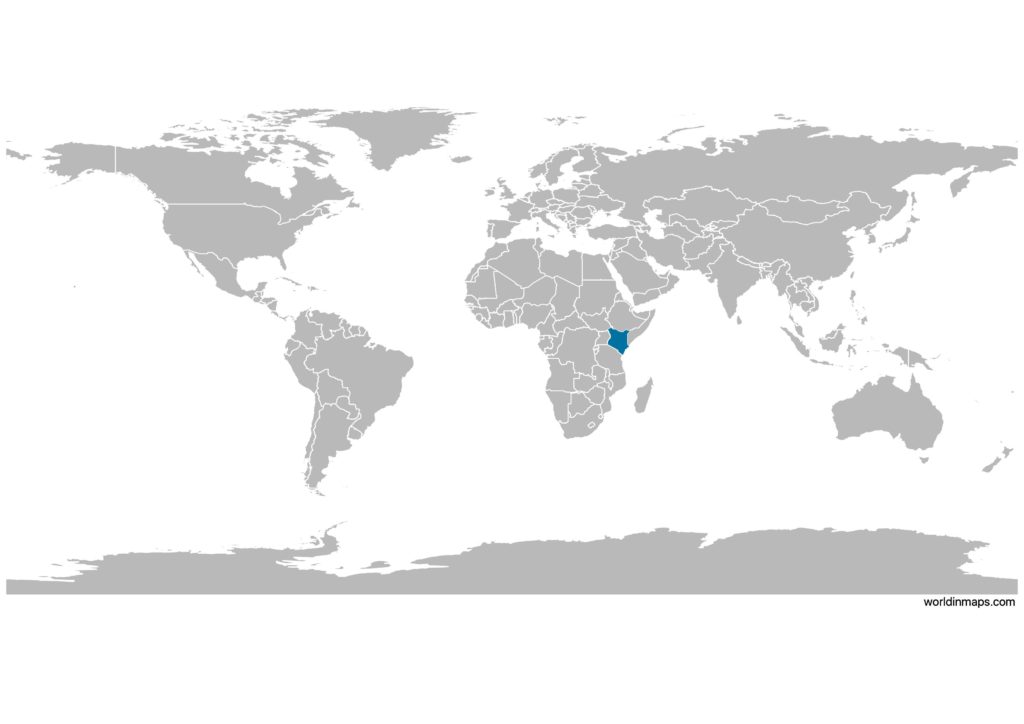Kenya

| Government | |
| Name | Republic of Kenya |
| Swahili | Jamhuri ya Kenya |
| Government type | Presidential republic |
| Capital | Nairobi (4,397,073 (2019)) |
| Currency | Kenyan shilling (KSH) |
| Organization | |
| Member State | Commonwealth of Nations |
| People | |
| Population (2020) | 53,771,300 (29th) |
| Density of population | 78 P/km2 (124th) |
| Nationality | Kenyan |
| Official languages | |
| English | |
| Kiswahili | |
| Ethnic groups (2019) | |
| Kikuyu | 17.1% |
| Luhya | 14.3% |
| Kalenjin | 13.4% |
| Luo | 10.7% |
| Kamba | 9.8% |
| Somali | 5.8% |
| Kisii | 5.7% |
| Mijikenda | 5.2% |
| Meru | 4.2% |
| Maasai | 2.5% |
| Turkana | 2.1% |
| Non-Kenyan | 1% |
| Other | 8.2% |
| Religions (2009) | |
| Christian | 85.5% |
| Protestant | 33.4% |
| Catholic | 20.6% |
| Evangelical | 20.4% |
| African Instituted Churches | 7% |
| Other Christian | 4.1% |
| Muslim | 10.9% |
| Other | 1.8% |
| None | 1.6% |
| Don’t know/no answer | 0.2% |
| Life expectancy (2020) | |
| Male | 67.3 years |
| Female | 70.6 years |
| Total population | 69 years (173rd) |
| Homicides | |
| Total (2018) | 4.9 per 100,000 people (65th) |
| Geography | |
| Land area | 569,140 km2 |
| water area | 11,227 km2 |
| total area | 580,367 km2 (50th) |
| Mean elevation | 762 m |
| Lowest point | |
| Indian Ocean | 0 m |
| Highest point | |
| Mount Kenya | 5,199 m |
| Land use (2011) | |
| Agricultural land | 48.1% |
| Arable land | 9.8% |
| Permanent crops | 0.9% |
| Permanent pasture | 37.4% |
| Forest | 6.1% |
| Other | 45.8% |
| Urbanization | |
| Urban population (2020) | 28% |
| Rate of urbanization | 4.23% annual rate of change (2015 – 2020) |
| Economy | |
| Labor force (2017) | 19.6 million (30th) |
| Labor force by occupation (2005) | |
| Agriculture | 61.1% |
| Industry | 6.7% |
| Services | 32.2% |
| Unemployment rate (2013) | 40% (214th) |
| GDP (PPP) (estimate 2020) | |
| Total | $206.532 billion |
| Per capita | $4,071 |
| GDP (nominal) (estimate 2020) | |
| Total | $109.116 billion |
| Per capita | $2,151 |
| GDP by sector (estimate 2017) | |
| Agriculture | 34.5% |
| Industry | 17.8% |
| Services | 47.5% |
| Exports (2017) | $5.792 billion (104th) |
| Exports partners (2017) | |
| Uganda | 10.8% |
| Pakistan | 10.6% |
| US | 8.1% |
| Netherlands | 7.3% |
| UK | 6.4% |
| Tanzania | 4.8% |
| UAE | 4.4% |
| Imports (2017) | $15.99 billion (85th) |
| Imports partners (2017) | |
| China | 22.5% |
| India | 9.9% |
| UAE | 8.7% |
| Saudi Arabia | 5.1% |
| Japan | 4.5% |
Kenya on the world map

Kenya top 10 largest cities (2019)
- Nairobi (4,397,073)
- Mombasa (1,208,333)
- Nakuru (570,674)
- Ruiru (490,120)
- Eldoret (475,716)
- Kisumu (397,957)
- Kikuyu (323,881)
- Thika (251,407)
- Naivasha (198,444)
- Karuri (194,342)
Demography
Population pyramid

Age structure data
Estimate for 2020:
- 0-14 years: 38.71% (male 10,412,321/female 10,310,908)
- 15-24 years: 20.45% (male 5,486,641/female 5,460,372)
- 25-54 years: 33.75% (male 9,046,946/female 9,021,207)
- 55-64 years: 4.01% (male 1,053,202/female 1,093,305)
- 65 years and over: 3.07% (male 750,988/female 892,046)
Remark: the age structure of a population affects a nation’s key socioeconomic issues. Countries with young populations (high percentage under age 15) need to invest more in schools, while countries with older populations (high percentage ages 65 and over) need to invest more in the health sector. The age structure can also be used to help predict potential political issues. For example, the rapid growth of a young adult population unable to find employment can lead to unrest.
Population from 1950 to 2020
Source: United Nations, Department of Economic and Social Affairs, Population Division (2019). World Population Prospects 2019, Online Edition. Rev. 1.
Evolution of the life expectancy from 1960 to 2018
Source: World Development Indicators, The World Bank
Economy
Agriculture:
tea, coffee, corn, wheat, sugarcane, fruit, vegetables; dairy products, beef, fish, pork, poultry, eggs
Industries:
small-scale consumer goods (plastic, furniture, batteries, textiles, clothing, soap, cigarettes, flour), agricultural products, horticulture, oil refining; aluminum, steel, lead; cement, commercial ship repair, tourism, information technology
Exports – commodities:
tea, horticultural products, coffee, petroleum products, fish, cement, apparel
Imports – commodities:
machinery and transportation equipment, oil, petroleum products, motor vehicles, iron and steel, resins and plastics
Time zone and current time in Kenya
Go to our interactive map to get the current time in Kenya